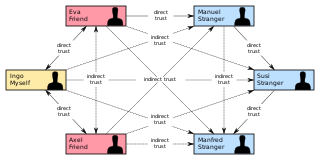Related Research Articles

In cryptography, encryption is the process of encoding information. This process converts the original representation of the information, known as plaintext, into an alternative form known as ciphertext. Ideally, only authorized parties can decipher a ciphertext back to plaintext and access the original information. Encryption does not itself prevent interference but denies the intelligible content to a would-be interceptor.
Kerberos is a computer-network authentication protocol that works on the basis of tickets to allow nodes communicating over a non-secure network to prove their identity to one another in a secure manner. Its designers aimed it primarily at a client–server model, and it provides mutual authentication—both the user and the server verify each other's identity. Kerberos protocol messages are protected against eavesdropping and replay attacks.
Pretty Good Privacy (PGP) is an encryption program that provides cryptographic privacy and authentication for data communication. PGP is used for signing, encrypting, and decrypting texts, e-mails, files, directories, and whole disk partitions and to increase the security of e-mail communications. Phil Zimmermann developed PGP in 1991.

Public-key cryptography, or asymmetric cryptography, is a cryptographic system that uses pairs of keys. Each pair consists of a public key and a private key. The generation of such key pairs depends on cryptographic algorithms which are based on mathematical problems termed one-way functions. Effective security requires keeping the private key private; the public key can be openly distributed without compromising security.

An email client, email reader or, more formally, message user agent (MUA) or mail user agent is a computer program used to access and manage a user's email.

In cryptography, a web of trust is a concept used in PGP, GnuPG, and other OpenPGP-compatible systems to establish the authenticity of the binding between a public key and its owner. Its decentralized trust model is an alternative to the centralized trust model of a public key infrastructure (PKI), which relies exclusively on a certificate authority. As with computer networks, there are many independent webs of trust, and any user can be a part of, and a link between, multiple webs.

Key exchange is a method in cryptography by which cryptographic keys are exchanged between two parties, allowing use of a cryptographic algorithm.
Key management refers to management of cryptographic keys in a cryptosystem. This includes dealing with the generation, exchange, storage, use, crypto-shredding (destruction) and replacement of keys. It includes cryptographic protocol design, key servers, user procedures, and other relevant protocols.
Key generation is the process of generating keys in cryptography. A key is used to encrypt and decrypt whatever data is being encrypted/decrypted.
Pirate decryption is the decryption, or decoding, of pay TV or pay radio signals without permission from the original broadcaster. The term "pirate" is used in the sense of copyright infringement. The MPAA and other groups which lobby in favour of intellectual property regulations have labelled such decryption as "signal theft" even though there is no direct tangible loss on the part of the original broadcaster, arguing that losing out on a potential chance to profit from a consumer's subscription fees counts as a loss of actual profit.
In cryptography and steganography, plausibly deniable encryption describes encryption techniques where the existence of an encrypted file or message is deniable in the sense that an adversary cannot prove that the plaintext data exists.
End-to-end encryption (E2EE) is a system of communication where only the communicating users can read the messages. In principle, it prevents potential eavesdroppers – including telecom providers, Internet providers, malicious actors, and even the provider of the communication service – from being able to access the cryptographic keys needed to decrypt the conversation.
Proxy re-encryption (PRE) schemes are cryptosystems which allow third parties (proxies) to alter a ciphertext which has been encrypted for one party, so that it may be decrypted by another.
Broadcast encryption is the cryptographic problem of delivering encrypted content over a broadcast channel in such a way that only qualified users can decrypt the content. The challenge arises from the requirement that the set of qualified users can change in each broadcast emission, and therefore revocation of individual users or user groups should be possible using broadcast transmissions, only, and without affecting any remaining users. As efficient revocation is the primary objective of broadcast encryption, solutions are also referred to as revocation schemes.
Card sharing, also known as control word sharing, is a method of allowing multiple clients or digital television receivers to access a subscription television network with only one valid subscription card. This is achieved by electronically sharing a part of the legitimate conditional access smart card's output data, enabling all recipients to gain simultaneous access to scrambled DVB streams, held on the encrypted television network.
Email encryption is encryption of email messages to protect the content from being read by entities other than the intended recipients. Email encryption may also include authentication.
Forward anonymity is a property of a cryptographic system which prevents an attacker who has recorded past encrypted communications from discovering the its contents and participants in the future. This property is analogous to forward secrecy.
Threema is a paid open-source end-to-end encrypted instant messaging application for iOS and Android.
Identity-based conditional proxy re-encryption (IBCPRE) is a type of proxy re-encryption (PRE) scheme in the identity-based public key cryptographic setting. An IBCPRE scheme is a natural extension of proxy re-encryption on two aspects. The first aspect is to extend the proxy re-encryption notion to the identity-based public key cryptographic setting. The second aspect is to extend the feature set of proxy re-encryption to support conditional proxy re-encryption. By conditional proxy re-encryption, a proxy can use an IBCPRE scheme to re-encrypt a ciphertext but the ciphertext would only be well-formed for decryption if a condition applied onto the ciphertext together with the re-encryption key is satisfied. This allows fine-grained proxy re-encryption and can be useful for applications such as secure sharing over encrypted cloud data storage.
The Web Cryptography API is the World Wide Web Consortium’s (W3C) recommendation for a low-level interface that would increase the security of web applications by allowing them to perform cryptographic functions without having to access raw keying material. This agnostic API would perform basic cryptographic operations, such as hashing, signature generation and verification and encryption as well as decryption from within a web application.
References
- ↑ Richard Clayton, Hiding: Anonymity Systems, http://www.cl.cam.ac.uk/~rnc1/notes/AT02_hiding.pdf, lecture notes, 2002.
- ↑ Between Silk and Cyanide – a Codemaker’s War 1941-1945, Leo Marks, HarperCollins 1998.
- ↑ Ross Anderson, Security Engineering: A Guide to Building Dependable Distributed Systems, chapter 20, page 428, Wiley 2001, ISBN 0-471-38922-6 (paperback, 641pp.) Available online at http://www.cl.cam.ac.uk/~rja14/book.html